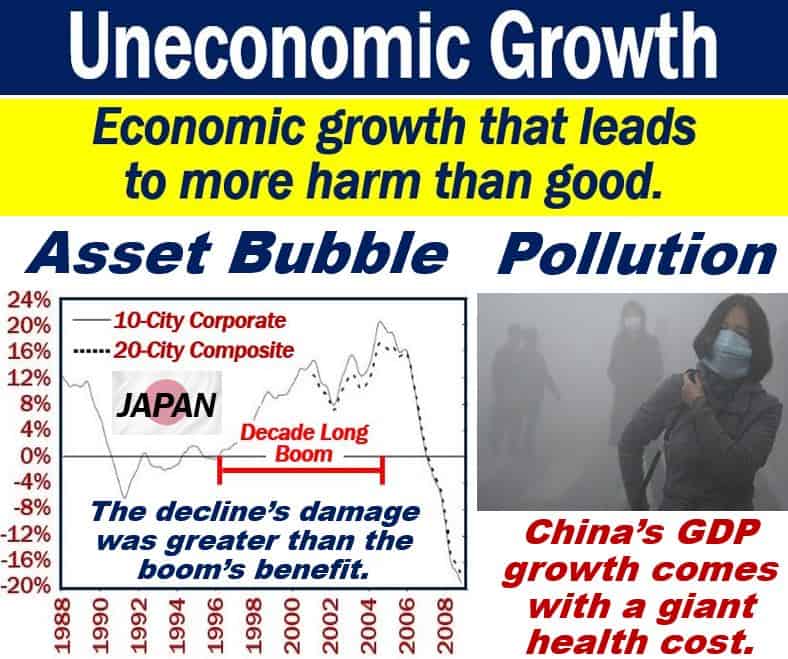Uneconomic Growth exists when the benefits of economic growth are less than the negative consequences of that economic expansion. Uneconomic growth may occur when the growth in the economy leads to negative environmental, economic, or social consequences. It may also occur when that level of GDP growth is not sustainable and eventually results in future problems.
GDP stands for gross domestic product, i.e., all the goods and services that the economy produces.
Steady State Revolution says the following regarding uneconomic growth:
“When social or environment costs become larger than the benefits of more production and consumption growth is no longer economic.”
Uneconomic growth – asset bubbles
Dramatic increases in the price of real estate, investments, or other assets may boost economic growth in the short term.
For example, a fast-moving real estate market, i.e., houses selling rapidly, can generate lots of taxable income. It is great for sellers because prices keep rising. However, the boom is not producing real economic value.
These asset bubbles invariably damage the economy when they burst.

Sometimes we need to take our foot off the accelerator. Otherwise, we could be undermining our future, or perhaps the future of generations to come.
Uneconomic growth – ecology
Sometimes, economic growth may reach a point in which its benefits are less than its harms to the environment. In other words, there is too much ecological damage. Ecological damage means damage to our physical surroundings, i.e., our environment.
Continuous uneconomic growth can lead to the depletion of natural resources, making it increasingly difficult to sustain economic activities without causing irreversible environmental harm.
Concerns about possible detrimental effects of GDP growth on the environment lead some people to advocate for slower growth.
Many green parties across the world argue that our economies form part of a global society. They also say that a global society and a global ecology cannot outstrip their natural growth without causing harm.
Ecological damage – example
Let’s imagine that John Doe Widgets Inc. opens a giant factory near a medium-sized town. John Doe produces small plastic widgets. The new factory is great for the economy because it creates jobs and additional revenue for the government.
However, it also dumps toxins into the town’s water supply. The consequences of this damage are greater than the economic benefits.
Water pollution is a problem that has been getting worse across the world. Pollution refers to something in the environment that should not be there and may be harmful. Noise, chemicals, sewage, artificial light, and vehicle fumes, for example, are seen as pollutants if they damage our health or the environment.
Moreover, uneconomic growth can also exacerbate social inequalities and health issues, as marginalized communities often bear the brunt of environmental degradation and lack of access to clean resources.
Nineteenth-century British political economist, David Ricardo, worried about population growth. He said that the human population would eventually exceed nature’s capacity to provide for much more than subsistence.
Ricardo, a believer in free trade and a free market economy, continues influencing economic thinking today.
Video – What is Uneconomic Growth?
This educational video, from our sister channel on YouTube – Marketing Business Network, explains what a ‘Uneconomic Growth’ is using simple and easy-to-understand language and examples.
